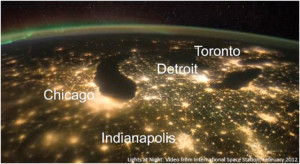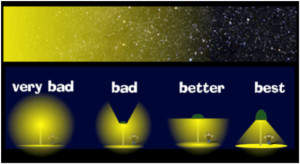What do you see at night when you look up? If you travel back in time and pose the question to Thomas Jefferson, he would probably say something along the lines of, “I see an uncountable number of bright, shining stars, and I also see a milky band that looks like a faint cloud that spans the sky.” Today, however, the answer to that question for almost every American would likely be, “I can see six, maybe seven stars, but I also see an orange glow around the horizon.” The milky white cloud that was seen back then is called the Milky Way Galaxy. We are inside the Milky Way, along with billions and billions of other stars. What is seen as a “milky patch” is actually a giant cloud of dust that is illuminated by all of the stars in our galaxy. Now why did the modern person not see this milky band, and why did he only see six or seven stars accompanied by that strange orange glow? The answer is simple: light pollution.
Light Pollution? How does a light “pollute” the sky? Lights used in outdoor lighting don’t only shine down onto the ground, but rather a good deal of their light is directed up into the night sky. In populated areas, the effect of millions of light bulbs shining throughout the night severely limits the number of stars we can see in the night sky. From Morris County, anyone who looks east directly above the horizon can clearly see the orange glow that stems from the light pollution in New York City. This rapid transformation of the appearance of the night sky has changed how most people think about the night. To see a relative example, I have taken a picture of the Orion Nebula from my backyard. Compared to it is the same object, the same interstellar cloud of gas and dust where stars are being formed, but taken from space by the Hubble Space Telescope. Hubble is free of light pollution because it is in space, so it provides some of the best images we have the ability to take.
Furthermore, light pollution is not just a harmless inconvenience to stargazers. In an advancing society where the night is no longer a time solely for sleep, many street lights and buildings remain light throughout the entire night. This results in wasted energy, as parking lots and shopping centers have lights on all night. The International Dark-Sky Association in Tucson, Arizona, an environmental group, estimates that “one-third of all lighting in the U.S. is wasted, at an annual cost of about 30 million barrels of oil and 8.2 million tons of coal- a total of about 2 billion U.S. dollars. That oil amounts to generating 14.1 million tons of CO2 per year into the atmosphere.” Wasting $2 billion yearly on misused lighting is an issue that begs to be fixed. From space, astronauts capture what the night on Earth looks like. 
The harm of light pollution does not only hurt a person’s wallet, but it destroys the habitat that they live in. Sea turtles have been nesting on beaches for millions of years, but a recent study shows a decline in this activity. It turns out that turtles avoid brightly light beaches when laying eggs on the shore. With an ever decreasing number of locations to lay their eggs, the turtle population is decreasing. Even if a mother is lucky enough to lay her eggs on a beach, the hatchlings can easily get disorientated by the bright city lights and wander inland, which spells certain death for the innocent creature. Birds fall prey to city lights as well: it is estimated that 4 to 5 million migrating birds die each year from flying into towers that they were visually attracted to by their light. Humans, according to various studies, disrupt their circadian rhythm by being exposed to more light than naturally provided. Many other species, such as zooplankton, are negatively affected by light pollution. This disruption in the wild will create unbalanced food chains, which is harmful for everyone.
There is hope for this dilemma to be solved, and it is simpler than you may think. Turning your lights off is a straightforward solution to this problem. Other people, however, feel insecure if their home is not lit. You can keep a light on at night, but the type of light will determine how much it will pollute the sky. Not all lighting fixtures are equal. The diagram below demonstrates that simply directing the beam of light down will result in better lighting and also reduce light pollution. Such lighting fixtures can be purchased at your local hardware store.

Tonight take a step outdoors and look up. While you are looking up at the bland urban sky, imagine what it would look like if there was, say, a power outage, and every light in the area went out. Thomas Jefferson, if standing beside you, would feel at home. The sky doesn’t change; humans just unknowingly hide the sky’s beauty from themselves. Please, turn your lights down, so we can all see what is up.

